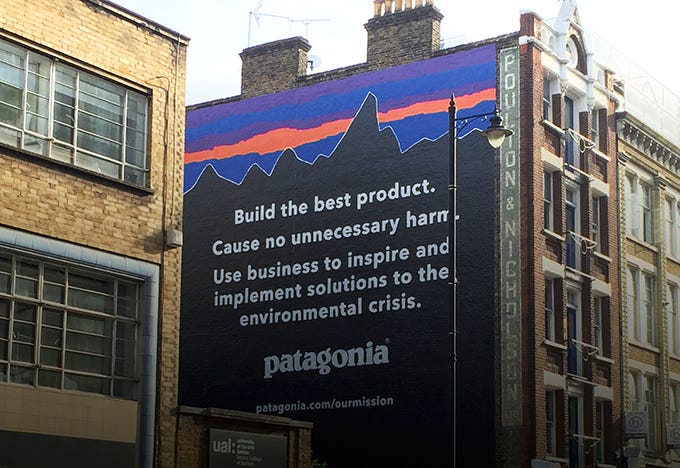28 September 2022. Peace | Business
Oranges, conflict, and peace-building // Patagonia makes the Earth its shareholder
Welcome to Just Two Things, which I try to publish daily, three days a week. Some links may also appear on my blog from time to time. Links to the main articles are in cross-heads as well as the story. A reminder that if you don’t see Just Two Things in your inbox, it might have been routed to your spam filter. Comments are open.
1: Oranges, conflict and peace-building
PACSS is a UK Research Institute programme that is coming to the end of its funding line and mark that, it has produced an online collection that includes accessible accounts of the research it has supported across peace, conflict and security. It’s a rich review of current research. Each section is prefaced by a guest contribution, and together with my SOIF colleagues April Ward and Cat Tully, we contributed a preface to the ‘peace’ section.
We focussed partly on the connections between peace studies and futures studies. These are surprisingly extensive, even if they seem to be recovered, in every generation, from the noise of business futures and geopolitical/military futures applications.
Going back much of the credible visioning practices in futures work comes out of Elise Boulding and Warren Ziegler’s peacebuilding workshops. Johann Galtung and Robert Jungk, both active in promoting peace, were instrumental in creating the 1967 Mankind 2000 conference, which was an attempt to democratise futures. (It’s fair to say that it did have this effect eventually, but not through the means they anticipated, or the timescale.) More recently, Adam Kahane’s practice around ‘generative futures’ has often been directed at peace building dialogues.
My contribution to our article was around the history of futures. April, on the other hand, is a specialist in peace and futures (it’s her doctoral subject), and she pointed me to a couple of blog posts of hers that discussed Galtung’s work in the area.
The first was about his model of peace-building that has three elements:
Galtung... is particularly known for having developed the "conflict triangle." This triangle demonstrates the three key elements that often combine to create violent conflict. The triangle also highlights how peace work should be specifically focussing all three elements of conflict in order to be successful. The three elements of violent conflict are: Attitudes/Assumptions, Contradictions, and Behaviour: ABC.
There’s a short video explaining this on youtube:
Galtung’s ‘TRANSCEND’ model is also influential in the area. The second post references an exercise that features in his book on the method. He designed it to open up conversations about peace and conflict:
Imagine a table. On that table is one orange. Sitting at the table are two children. What happens to the orange?
(Image by Evan Amos, via Wikipedia. CC BY-SA 3.0)
April has tried this out on her friends and family, and you can imagine the responses. Some obvious ones jump out: One child may justify taking the orange, based on status or need. The children might divide the orange between them, equally or not. They might disagree, and the orange sits on the table, accusingly or temptingly. One child might just take it. Or they ask someone else to make the decision for them.
Galtung generated 16 responses, and his may not be a complete list. But some of the later responses in his list—identified as ‘more creative’ responses—are worth quoting here:
Another please?: the kids ask the teacher for another orange because she forgot one child...
Transformation: the kids bake a small orange cake. Then have a lottery and share the proceeds gained from the sale of the cake.
Time is worth it: the kids eat the orange by division, they save the seeds and plant them. Some time later that tree produces oranges, which they in turn share, eat, and re-plant and in time create a profitable orange grove business together.
I liked these because they re-framed, or re-perceived, the issue. It’s also hard to read examples about oranges without thinking, at least subliminally, about Israel and Palestine.
But the main thing I took away from my conversations with April while we were developing the thinking was the extent to which peace is still seen as an interlude between conflict, rather than a normal state of affairs interrupted by outbreaks of aggression. I hadn’t realised the extent to which I had internalised this ‘Westphalian’ view of the way the world might be supposed to work. The ‘Realism’ school is international relations runs deep.
And that’s how we ended the article:
In the long run, however, the biggest agenda for peace building is this: how do we change the discourse around peace so that it is seen as a transformative state, and not merely an interregnum between states of conflict? This is the message of Galtung’s story about the children and the oranges, and it has a distinguished history within futures practice... (T)he question (Elise Boulding) asked repeatedly, across hundreds of visioning workshops, is as timely as it ever was: “How do we make a world without weapons?”
2: Patagonia makes the Earth its shareholder
It’s worth having a read of the short letter in which Yvon Chouinard explains why he and his family have handed over all the shares in the Patagonia clothing company to a trust.
The headline:
Earth is now our only shareholder.
Some of the FAQs are interesting too.
For those who aren’t that familiar with Patagonia: it makes outdoor clothing, it is aggressively purpose, values and environmentally driven. And it is acutely aware that while it makes a living from selling clothes to consumers, that consumption is driving our entwined environmental and biodiversity crises:
We started with our products, using materials that caused less harm to the environment. We gave away 1% of sales each year. We became a certified B Corp and a California benefit corporation, writing our values into our corporate charter so they would be preserved. More recently, in 2018, we changed the company’s purpose to: We’re in business to save our home planet. While we’re doing our best to address the environmental crisis, it’s not enough.
Famously, the company ran an ad in the New York Times a few years ago on the uber-US sales promotion day ‘Black Friday’ asking people not to buy from it. It has run repair clinics so people can mend their Patagonia products rather than replacing them. And yet the company goes from strength to strength.
(Image via thedropdate.com. Used with thanks.)
Chouinard is in his 80s now, and has stepped back from day to day running of the company. But he and his family wanted to make sure that Patagonia’s environmental and social stance continued. And it turned out that there weren’t that many options, as the letter explains:
One option was to sell Patagonia and donate all the money. But we couldn’t be sure a new owner would maintain our values or keep our team of people around the world employed.
Another path was to take the company public. What a disaster that would have been. Even public companies with good intentions are under too much pressure to create short-term gain at the expense of long-term vitality and responsibility.
Hence the decision to give the company to a trust, which he describes like this:
Instead of “going public,” you could say we’re “going purpose.” Instead of extracting value from nature and transforming it into wealth for investors, we’ll use the wealth Patagonia creates to protect the source of all wealth.
The letter outlines the mechanics: the voting shares are held by one trust, that protects the company’s values, the non-voting shares by another one, and “the money we make after reinvesting in the business will be distributed as a dividend to help fight the crisis.”
As it happens, the American academic Ken Pucker has an article at The Conversation which tries to place Patagonia’s decision in context. This piece has some piquancy because Pucker used to work for Timberland, another American outdoor clothing and footwear business:
Timberland’s model blended “commerce and justice” by combining the pursuit of profit with respect for global human rights, support for community service and a commitment to environmental stewardship.
At the time, it was privately owned: it’s now part of the conglomerate that also owns Vans and The North Face, although so far it seems to have maintained its values and its community engagement.
Pucker puts the Patagonia decision in the wider context of a shift of business away from ‘shareholder value’ towards “stakeholder capitalism”, marked by the 2019 declaration of the US Business Roundtable, which represents some 200 US CEOs. But as he says, so far that declaration has been largely performative, at least according to some 2020 Harvard research:
the researchers examined 26 proposals that shareholders had introduced with the goal of implementing the roundtable’s statement. “Each company invariably opposed these proposals,” the study observed.
Pucker observes that this isn’t surprising: the companies are responding rationally to the incentive systems within which they are operating:
When presented with a situation in which social welfare and private profits align, companies will act sustainably. However, when circumstances pit public welfare against a company’s bottom line, executives typically side with their shareholders.
Patagonia has a very particular history. Although it has been wildly successful, Chouinard is something of an accidental entrepreneur who got into making outdoor equipment and clothing because he was a rock climber who was dissatisfied by what he could buy. His family has also maintained control of the stock. I don’t expect many, or any, of the Business Roundtable companies will be following his lead any time soon.
On the other hand, every radical act creates a more diverse range of examples for others to study and to emulate. In his piece, Ken Pucker describes the Patagonia decision as an example of “moral courage”. It’s more than that, though. It’s also a moral template.
j2t#372
If you are enjoying Just Two Things, please do send it on to a friend or colleague.




